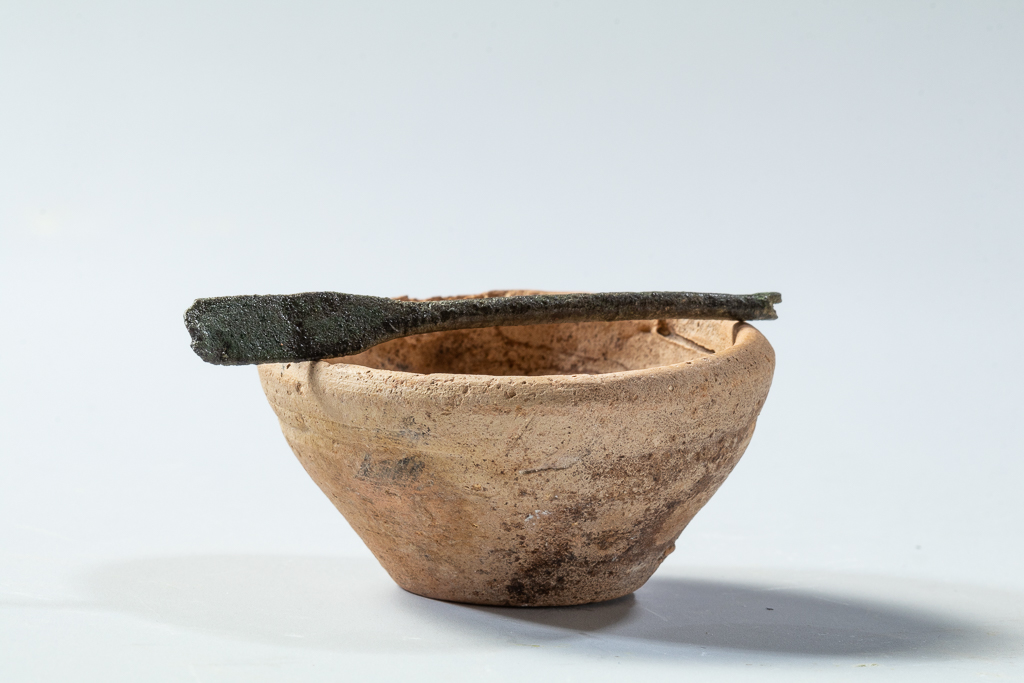Title: Four bronze spatulas - 2018.09
Acquisition number: 2018.09
Author or editor: Emma Griggs
Culture or period: Hellenistic.
Date: 4th century BC - 1st century AD.
Material: Metal - Bronze
Object type: Tools and instruments
Origin region or location: Syria
Origin city: Jebel Khalid.
Display case or on loan: 4
Display case previous: 6
Keywords: Jebel Khalid, Hellenistic
J.S. Milne, Surgical Instruments in Greek and Roman Times (Oxford, 1907), 58-61
H. Jackson, Jebel Khalid on the Euphrates, vol. 4: The Housing Insula, Mediterranean Archaeology Supplement 9 (Sydney, 2014), 590
M. Mazis, Jebel Khalid on the Euphrates, vol. 7: The Metals, Mediterranean Archaeology Supplement (Sydney, forthcoming)
2018.09
Four bronze spatulas
On loan from Professor Graeme Clarke AO FAHA, co-director of excavations at Jebel Khalid, Syria.
Hellenistic spatulas were small hand tools with a flat flexible blade used to pick up, mix, scrape and spread powders and paste. They usually had a handle, which could be used for stirring, mixing and grinding substances. The common view amongst ancient historians is that spatulas were used primarily in medicine and pharmaceutics, to prepare medicaments. Milne (1907) reported that almost every ancient medical author mentions spatulas in surgical and pharmaceutical applications. They would have been used to probe and sound subcutaneous disease or to cauterize, or were used as tongue depressors and, in some cases, to conduct blunt dissection. They are the most common surgical instrument found in museum collections. The frequency of finds in the archaeological context, however, does not suggest exclusive use in medical scenarios.
There is little evidence that the spatulas found at Jebel Khalid were used exclusively for medical or any other purpose. More likely, they were multi-functionary and not used for any one specific purpose. The spatulas found would have had various uses from preparing and applying cosmetics and paints, as writing tools, as hair- or clothes-pins and for measuring and dispensing quantities of ingredients. It has not been possible, however, to differentiate the specific function of each tool at Jebel Khalid. The spatulas were found predominantly in the insula, more than any other place at Jebel Khalid. Consequently, their location suggests that these spatulas were a principally a domestic phenomenon.
All of the spatulas were made of copper or copper alloy. Where analyses were possible, the alloy was predominantly leaded tin bronze. The main form of decoration on the spatulas is incised lines; the dominant blade shape is triangular, and the dominant shape of the handle end is olivary. The average length of the spatula is 11.8-11.9 cm, a suitable size for holding in hand. All of the spatulas held here, except for JK 95.283, are Jebel Khalid type 2. These spatulas have a straight, parallel edge and are generally undecorated.
The spatulas at Jebel Khalid could have been manufactured in a number of ways. They could have been cast in a mould and finished by hammering, filing and polishing. Simple forms without intricate moulding could have been drawn and hammered from rod stock. Another method of manufacture was rolling a flat piece of bronze, resulting in a hollow tool.
JK 01.275
Metal Inventory Number: FT434
Housing Insula, Area 74
Found in Phase B+ in the upper fill 2 which may have been a dump (Period 4 (100-70/60 BC). Datable finds: late fourth to mid-second century BC.
Length: 14.0cm; width 10cm; handle end: 0.5cm
The spatula is a copper alloy. It is a type 2 spatula that has a blade with parallel edges, oval base and olival handle. It has a rounded-end blade that is set at an obtuse angle.
JK 96.034
Metal Inventory Number: FT441
Housing Insula, Area 47
Upper fill, includes tumble and wash (Period 5 (c.70-60 BC- ?)) Datable finds: third to second century.
Length: 7.6cm, width 8cm; handle end diameter: 0.4cm
The spatula is type 2 and copper alloy. The spatula is fragmented and has a blade with a parallel edge. It perhaps had a straight-end blade. The blade is chipped.
JK 95.307
Metal Inventory Number: FT447
Housing Insula, Area 49
Upper fill includes tumble (period 5). Datable finds: Hellenistic to Umayyad period.
Length: 8cm; width: 6cm; handle end diameter: 0.4cm
Type 2 copper alloy spatula which has a blade with parallel edges. The spatula has incised decoration at the handle/ blade juncture. Fractured blade end.
JK 95.283
FT462
Palace, T50, Vestibule area/room 24
Floor (Period 3-4) datable finds: early second century AD
Length: 12.3 cm; handle end: 3.5cm
Copper alloy fragment of a spatula. The blade type is unclear. The spatula has incised decorations of parallel lines at the handle/blade juncture and further along the handle.
J.S. Milne, Surgical Instruments in Greek and Roman Times (Oxford, 1907), 58-61
H. Jackson, Jebel Khalid on the Euphrates, vol. 4: The Housing Insula, Mediterranean Archaeology Supplement 9 (Sydney, 2014), 590
M. Mazis, Jebel Khalid on the Euphrates, vol. 7: The Metals, Mediterranean Archaeology Supplement (Sydney, forthcoming)
Emeritus Professor Graeme Clarke.


